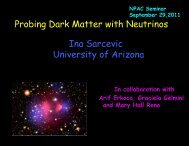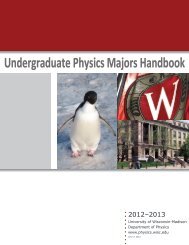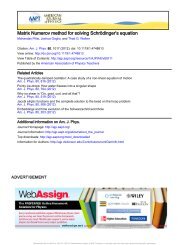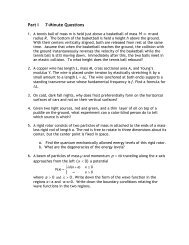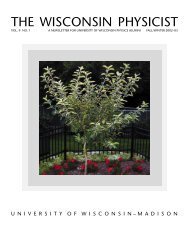Vol. 16 No. 1, 2011 - Department of Physics - University of ...
Vol. 16 No. 1, 2011 - Department of Physics - University of ...
Vol. 16 No. 1, 2011 - Department of Physics - University of ...
You also want an ePaper? Increase the reach of your titles
YUMPU automatically turns print PDFs into web optimized ePapers that Google loves.
The Wisconsin Physicist<br />
<strong>Department</strong> <strong>of</strong> <strong>Physics</strong><br />
1150 <strong>University</strong> Avenue<br />
Madison, WI 53706<br />
Tel: 608.262.4526<br />
Email: info@physics.wisc.edu<br />
Web: www.physics.wisc.edu<br />
<strong>Vol</strong>. <strong>16</strong> <strong>No</strong>.1 Spring <strong>2011</strong>
Inside this Issue<br />
Greetings from the Chair.................................................... 1<br />
Quantum Computing with Atoms, Semiconductors,<br />
and Superconductors.......................................................... 2<br />
The Wisconsin Physicist 3<br />
<strong>Vol</strong>. <strong>16</strong> <strong>No</strong>.1 Spring <strong>2011</strong><br />
What Neutrinos from Nuclear Reactors Tell us about<br />
the Early Universe............................................................... 4<br />
Undergraduate Student Degrees & Awards........................ 5<br />
Graduate Student Degrees & Awards ................................ 6<br />
Graduate Student Admissions............................................. 7<br />
Faculty & Staff Updates, Promotions, & Awards................. 8<br />
Dr. Maritza Irene Stapanian Crabtree.................................. 9<br />
In Memoriam.................................................................... 11<br />
Foundation Accounts........................................................ 13<br />
Giving................................................................................ 14<br />
<strong>University</strong> <strong>of</strong> Wisconsin<br />
<strong>Department</strong> <strong>of</strong> <strong>Physics</strong><br />
1150 <strong>University</strong> Avenue<br />
Madison, WI 53706<br />
Tel: 608.262.4526<br />
Fax: 608.262.3077<br />
Email: info@physics.wisc.edu<br />
Web: www.physics.wisc.edu<br />
Facebook: UW-Madison <strong>Department</strong> <strong>of</strong> <strong>Physics</strong><br />
On the Cover<br />
Photograph <strong>of</strong> the Daya Bay antineutrino<br />
detectors built by the UW neutrino group.<br />
Image courtesy <strong>of</strong> LBNL. The Daya Bay Reactor<br />
Neutrino Experiment (Daya Bay) is a US-China<br />
collaboration to search for and measure the<br />
yet unknown neutrino mixing angle 13<br />
. The<br />
experiment is located at the Daya Bay nuclear<br />
power plant near Hong Kong, China. Data<br />
taking will start in Summer <strong>2011</strong>.<br />
For more information:<br />
http://neutrino.physics.wisc.edu
The Wisconsin Physicist 1<br />
There have been a great number<br />
<strong>of</strong> exciting developments in the<br />
<strong>Physics</strong> <strong>Department</strong> during the<br />
last year. Despite the difficult financial<br />
constraints, we were able to add an<br />
excellent experimentalist, Dr. Reina<br />
Maruyama, to our faculty roster. Pr<strong>of</strong>.<br />
Maruyama works on neutrino and<br />
dark matter physics.<br />
Our faculty successfully competed for<br />
the campus-wide awards:<br />
• Pr<strong>of</strong>essor Pupa Gilbert has<br />
received the Chancellor’s<br />
Distinguished Teaching Award.<br />
• Pr<strong>of</strong>essor Karsten Heeger was<br />
awarded a Romnes Faculty<br />
Fellowship, funding <strong>of</strong> which<br />
comes from Wisconsin Alumni<br />
Research Foundation.<br />
• Postdoctoral research associate<br />
Dr. Ian Woo Kim, collaborating<br />
with Pr<strong>of</strong>essor Lisa Everett, was<br />
awarded Association <strong>of</strong> Korean<br />
Physicists in America (AKPA) <strong>2011</strong><br />
Outstanding Young Researcher<br />
Award.<br />
• Undergraduate student Daniel<br />
Lecoanet was named a Churchill<br />
Scholar. He subsequently won a<br />
five-year Fannie and John Hertz<br />
Foundation fellowship. Lecoanet<br />
was one <strong>of</strong> 15 winners in this year’s<br />
competition, chosen from almost<br />
600 applicants.<br />
The <strong>Department</strong> congratulates these<br />
colleagues for their outstanding<br />
accomplishments.<br />
High Energy experimentalist and<br />
former Chair, Pr<strong>of</strong>essor Lee Pondrom<br />
has retired after many years <strong>of</strong><br />
dedicated service to the <strong>Department</strong>.<br />
Lee will continue contributing to the<br />
<strong>Department</strong> as an emeritus pr<strong>of</strong>essor.<br />
View from the Chair<br />
Greetings<br />
A. Baha Balantekin<br />
Eugene P. Wigner Pr<strong>of</strong>essor and Chair, <strong>Department</strong> <strong>of</strong> <strong>Physics</strong><br />
Astrophysics Pr<strong>of</strong>essor Hakki<br />
Ogelman has retired after many<br />
years <strong>of</strong> dedicated service to the<br />
<strong>Department</strong>. Hakki will continue<br />
contributing to the <strong>Department</strong> as an<br />
emeritus pr<strong>of</strong>essor.<br />
During the academic year 2009-2010<br />
string phenomenologist Gary Shiu<br />
and high energy experimentalist<br />
Sridhara Dasu were promoted to<br />
the rank <strong>of</strong> pr<strong>of</strong>essor. Also during<br />
this academic year, plasma physics<br />
theorist Stanislav Boldyrev and<br />
condensed matter experimentalist<br />
Robert McDermott were promoted to<br />
associate pr<strong>of</strong>essor with tenure.<br />
Culminating a decade <strong>of</strong> planning,<br />
innovation and testing, construction<br />
<strong>of</strong> the world’s largest neutrino<br />
observatory, IceCube, was<br />
successfully completed on December<br />
17, 2010. The construction, primarily<br />
funded by the National Science<br />
Foundation and coordinated by the<br />
<strong>University</strong> <strong>of</strong> Wisconsin-Madison and<br />
underway since 2005, was completed<br />
on schedule and within budget.<br />
This project was among the most<br />
ambitious scientific construction<br />
projects ever attempted.<br />
The tenth Annual Awards Banquet<br />
was held in the Spring 2010. In<br />
addition to awards to outstanding<br />
students, Distinguished Alumni<br />
Fellow and Service Awards were<br />
presented. Distinguished Alumni<br />
Fellows were Gregory B. Jaczko<br />
and Steven Vigdor. The Honorable<br />
Gregory B. Jaczko is the Chairman<br />
<strong>of</strong> the U.S. Nuclear Regulatory<br />
Commission. Steven Vigdor is the<br />
Associate Laboratory Director for<br />
Nuclear and Particle <strong>Physics</strong> at the<br />
Brookhaven National Laboratory.<br />
Distinguished service awards went to<br />
Mary Stapanian and Juliette Apkarian<br />
for their interest in, caring for, and<br />
exceptional philanthropy to the<br />
students <strong>of</strong> the <strong>Physics</strong> <strong>Department</strong>.<br />
They have generously endowed<br />
an undergraduate award in the<br />
memory <strong>of</strong> Maritza Irene Stapanian<br />
Crabtree, daughter and sister. We<br />
were especially moved by Juliette’s<br />
description <strong>of</strong> her sister’s life and<br />
achievements.<br />
Whether you are an alumnus, friend,<br />
employee, or student, we appreciate<br />
your interest in and loyalty to the<br />
<strong>University</strong> <strong>of</strong> Wisconsin <strong>Physics</strong><br />
<strong>Department</strong>. We would very much<br />
like to hear from you and consider<br />
your stories for publication in the next<br />
newsletter – your favorite memories<br />
<strong>of</strong> the <strong>Physics</strong> <strong>Department</strong>, the UW,<br />
Madison – please write to us (print or<br />
via email: info@physics. You can also<br />
donate to the <strong>Physics</strong> <strong>Department</strong><br />
online by going to www.physics.wisc.<br />
edu/giving/index.html.<br />
If you wish to consult with a UW<br />
Foundation development <strong>of</strong>ficer on<br />
future gifts or other options, including<br />
estates, trusts, gifts-in-kind, or<br />
planned giving please contact Chris<br />
Glueck, UW Foundation at 608/265-<br />
9952 or chris.glueck@uwfoundation.<br />
wisc.edu.<br />
On behalf <strong>of</strong> the <strong>Department</strong>, I<br />
sincerely thank you, our alumni and<br />
friends, who have provided generous<br />
support to the <strong>Department</strong>. In these<br />
tough economic times you help us<br />
enormously to carry out our research,<br />
education, and outreach efforts.<br />
Finally, my term as Chair will end this<br />
coming August. As I get ready to turn<br />
over my duties to my successor, I was<br />
humbled to find out that the Division<br />
<strong>of</strong> Nuclear <strong>Physics</strong> <strong>of</strong> the American<br />
Physical Society chose to give me its<br />
Distinguished Service Award.
2 The Wisconsin Physicist<br />
Quantum Computing with Atoms,<br />
Semiconductors, and Superconductors<br />
Vacuum chamber used for quantum gate experiments with neutral Rb atoms (left) and measured controlled-not truth table (right).<br />
For more than 40 years the<br />
number <strong>of</strong> transistors that can<br />
be placed in an integrated<br />
circuit has doubled approximately<br />
every two years. This long term<br />
trend known as Moore’s law has<br />
radically transformed society and<br />
ushered in the present information<br />
age where pocket sized electronic<br />
devices running on batteries are<br />
capable <strong>of</strong> worldwide communication<br />
while harnessing data processing<br />
power that outstrips the capabilities<br />
<strong>of</strong> machines that once filled large<br />
laboratories. Moore’s law is expected<br />
to continue for not more than another<br />
decade. At that point transistors<br />
will have shrunk to the point where<br />
a single device contains but a small<br />
number <strong>of</strong> active dopant atoms,<br />
and further miniaturization will not<br />
be possible. From the perspective<br />
<strong>of</strong> classical computing the end <strong>of</strong><br />
Moore’s law will mean that further<br />
increases in information processing<br />
power are likely to proceed at a much<br />
slower rate than previously.<br />
Remarkably, the final limit <strong>of</strong> Moore’s<br />
law, where processing devices<br />
effectively contain single atoms, may<br />
turn out to be remembered, not as<br />
the end <strong>of</strong> 50 years <strong>of</strong> exponential<br />
technology development, but as<br />
the dawn <strong>of</strong> a new age <strong>of</strong> quantum<br />
information processing. Researchers<br />
in the <strong>Department</strong> <strong>of</strong> <strong>Physics</strong> are<br />
actively involved in developing<br />
this new type <strong>of</strong> information<br />
processing, both theoretically and by<br />
experimental demonstrations.<br />
In contrast to classical computing,<br />
quantum computing holds the<br />
promise <strong>of</strong> a revolutionary approach<br />
that can solve certain computational<br />
problems exponentially faster than<br />
any possible classical machine.<br />
How is this possible? It is well<br />
known that quantum mechanical<br />
objects are inherently probabilistic.<br />
We can predict the evolution <strong>of</strong><br />
a quantum dynamical system by<br />
solving the Schrödinger equation,<br />
but the calculation yields only relative<br />
probabilities for certain outcomes,<br />
instead <strong>of</strong> certain predictions. On the<br />
face <strong>of</strong> it a probabilistic result does<br />
not sound very useful for information<br />
processing where we normally require<br />
accurate and precise data.<br />
There is, however, another important<br />
facet <strong>of</strong> quantum mechanics that is<br />
crucial for information processing.<br />
Quantum systems can be described<br />
as being in a superposition <strong>of</strong> more<br />
than one state at a time. In a classical<br />
computer data is stored in digital<br />
bits, each <strong>of</strong> which takes the value<br />
<strong>of</strong> either 0 or 1 at a given time. If a<br />
quantum system is used to represent<br />
one bit <strong>of</strong> data, the quantum bit,<br />
known as a qubit, can be both 0 and<br />
1 at the same time, i.e.<br />
|y> = c 0<br />
|0>+c 1<br />
|1>, where c 0<br />
and c 1<br />
are<br />
complex amplitudes. Of course when<br />
we make a measurement <strong>of</strong> the qubit<br />
the result is a definite value, 0 or 1,<br />
according to the probabilities |c 0<br />
| 2 or<br />
|c 1<br />
| 2 respectively.
A collection <strong>of</strong> N such qubits can then<br />
represent all 2 N possible data values<br />
<strong>of</strong> an N bit register simultaneously!<br />
This behavior is markedly different<br />
from a classical N bit register which<br />
can be used to store 2 N different<br />
values, but only one at a time. The<br />
use <strong>of</strong> qubits as opposed to classical<br />
bits thus leads to the possibility <strong>of</strong><br />
powerful parallel processing since<br />
2 N different values can be input to<br />
a quantum processor at one time.<br />
Although the power <strong>of</strong> a quantum<br />
computer stems in part from quantum<br />
superposition it is still true that the<br />
probabilistic nature <strong>of</strong> quantum<br />
mechanics renders the result <strong>of</strong> a<br />
quantum computation uncertain.<br />
Nevertheless there are certain<br />
computational problems where the<br />
probabilistic nature <strong>of</strong> the result is not<br />
problematic. These types <strong>of</strong> problems<br />
are characteristically asymmetric. The<br />
answer may be exponentially difficult<br />
to find, but given a candidate answer<br />
it is easy to verify whether or not the<br />
answer is correct. Such problems<br />
include finding the factors <strong>of</strong> a many<br />
digit number, which is important<br />
for cryptography, and searching in<br />
an unsorted database. Quantum<br />
algorithms which outperform any<br />
imaginable classical computer exist<br />
for both <strong>of</strong> these problems, as well<br />
as several others. In addition to<br />
solving numerical problems, quantum<br />
processors will enable the simulation<br />
<strong>of</strong> complex quantum systems, which<br />
will be an aid to the development <strong>of</strong><br />
new types <strong>of</strong> materials and sensors.<br />
From a fundamental perspective<br />
quantum information science<br />
seeks to further our understanding<br />
<strong>of</strong> the foundations <strong>of</strong> quantum<br />
theory by putting strikingly nonclassical<br />
aspects <strong>of</strong> the theory such<br />
as non-locality and macroscopic<br />
superposition states to stringent<br />
experimental tests.<br />
The basic idea <strong>of</strong> data processing<br />
with quantum systems dates back<br />
to the 1980s but the field did not<br />
take <strong>of</strong>f until the 1990s with the<br />
discovery <strong>of</strong> the factorization and<br />
search algorithms as well as the<br />
initial development <strong>of</strong> physical<br />
platforms which could be used<br />
for implementing quantum logic<br />
operations. Since then the field<br />
has grown explosively with many<br />
thousands <strong>of</strong> scientists worldwide<br />
now working on quantum information<br />
problems.<br />
The UW Madison <strong>Physics</strong> <strong>Department</strong><br />
is playing an active role in the<br />
development <strong>of</strong> quantum information<br />
science. Starting from nothing ten<br />
years ago there are now seven<br />
faculty and one scientist involved<br />
in a broad range <strong>of</strong> experimental<br />
and theoretical projects that are<br />
supported by external research<br />
grants totaling more than $5,000,000<br />
annually. The leading candidates for<br />
implementing quantum computing<br />
hardware are currently trapped<br />
ions, neutral atoms, photons,<br />
semiconductor quantum dots and<br />
superconductors. UW Madison has<br />
strong experimental efforts exploring<br />
three <strong>of</strong> these five approaches.<br />
Pr<strong>of</strong>essor Mark Eriksson works on<br />
quantum dots in Si heterostructures,<br />
Pr<strong>of</strong>essor Robert McDermott is<br />
building superconducting circuits,<br />
and Pr<strong>of</strong>essors Mark Saffman<br />
and Thad Walker are developing<br />
neutral atom qubits trapped by<br />
optical beams. In parallel with the<br />
experimental activities Pr<strong>of</strong>essors<br />
Susan Coppersmith, Robert Joynt,<br />
and Maxim Vavilov, as well as<br />
Research Scientist Mark Friesen, are<br />
studying theoretical issues related<br />
to implementations as well as the<br />
development <strong>of</strong> new algorithms that<br />
can harness the potential <strong>of</strong> quantum<br />
hardware.<br />
The Wisconsin Physicist 3<br />
Development <strong>of</strong> a quantum computer<br />
that can outperform classical<br />
machines will require coherent<br />
control <strong>of</strong> a large number <strong>of</strong> qubits<br />
and is probably decades away. The<br />
current state <strong>of</strong> the art is limited to<br />
the coherent evolution <strong>of</strong> a small<br />
number <strong>of</strong> qubits, at most 14 in<br />
recent experiments with trapped<br />
ions from Rainer Blatt’s group in<br />
Austria. Recent experiments from<br />
the Saffman-Walker collaboration<br />
were the first to demonstrate a<br />
fundamental two-qubit logic gate<br />
with neutral atoms, which they then<br />
used to deterministically create<br />
an entangled, non-classical state<br />
<strong>of</strong> two-atoms. A picture <strong>of</strong> the<br />
experimental apparatus and the<br />
CNOT gate results are shown in the<br />
figure. Neutral atoms in optical traps<br />
have great potential for scalability to<br />
larger systems and ongoing work is<br />
seeking to build a device with 50 or<br />
more qubits. The quantum dot and<br />
superconductor based approaches<br />
also being developed at Madison<br />
have the potential for very fast gates<br />
operating at GHz rates. Future<br />
quantum processors may rely on<br />
hybrid approaches that connect<br />
different types <strong>of</strong> qubits to take<br />
advantage <strong>of</strong> the best characteristics<br />
<strong>of</strong> each. The presence <strong>of</strong> strong<br />
efforts using several different<br />
approaches in Madison therefore<br />
bodes well for future advances in this<br />
exciting and active field.<br />
For more information visit<br />
http://qc.physics.wisc.edu
4 The Wisconsin Physicist<br />
What Neutrinos from Nuclear Reactors Tell us<br />
about the Early Universe<br />
A US-China collaboration preparing for the next discovery in neutrino physics<br />
Neutrinos are among the most<br />
abundant particles in the<br />
Universe. They have been with us<br />
since the beginning <strong>of</strong> time and continue<br />
to be produced in nuclear reactions<br />
both in the cosmos and on Earth. The<br />
Sun, cosmic rays, and exploding stars<br />
all emit copious amounts <strong>of</strong> neutrinos<br />
or antineutrinos that can be detected<br />
by experiments on Earth. Man-made<br />
neutrinos from accelerators or nuclear<br />
reactors complement the rich spectrum <strong>of</strong><br />
naturally produced neutrinos. Neutrinos<br />
can be found all around us, and every<br />
second billions <strong>of</strong> them stream through<br />
our bodies and the Earth unhindered<br />
by matter. They are pointlike, weakly<br />
interacting particles that pass through<br />
most matter. The interaction <strong>of</strong> neutrinos<br />
is so small that roughly once every 30<br />
years there is a chance <strong>of</strong> a neutrinos<br />
interacting in your body.<br />
The weak interaction <strong>of</strong> neutrinos makes<br />
it one <strong>of</strong> the most elusive and most<br />
difficult to detect elementary particles. It<br />
took some 26 years after the theoretical<br />
postulate <strong>of</strong> the neutrino by Wolfgang<br />
Pauli in 1930 to establish experimentally<br />
the existence <strong>of</strong> this particle. In a<br />
groundbreaking experiment, conducted<br />
by Fred Reines, a nuclear reactor was<br />
used as the source <strong>of</strong> neutrinos. These<br />
neutrinos were detected in a large liquid<br />
scintillator detector very similar to the<br />
detectors used in modern experiments.<br />
Neutrinos were long thought to be<br />
massless and with little influence on<br />
everyday world. They were found to come<br />
in three different types associated with<br />
the lepton (electron, muon, or tau) that<br />
they were produced with. This discovery<br />
that neutrinos have a small, yet finite mass<br />
by the Super-Kamiokande experiment in<br />
1998 changed this picture dramatically.<br />
We now know that neutrinos have the<br />
ability to change from one kind into<br />
another through a quantum mechanical<br />
process called flavor change or neutrino<br />
oscillation. We have learned that all<br />
neutrinos in the Universe together have<br />
almost as much mass as all the stars we<br />
see in the night sky. Neutrinos are key to<br />
many fundamental processes. They are<br />
produced in nuclear and particle decays<br />
and play a key role in the supernova<br />
explosion <strong>of</strong> stars. Neutrinos carry most <strong>of</strong><br />
the energy <strong>of</strong> a supernova burst and they<br />
are an advance signal <strong>of</strong> the supernova<br />
explosion before light can even escape<br />
from the star.<br />
The discovery <strong>of</strong> neutrino flavor oscillation<br />
and neutrino mass has pr<strong>of</strong>oundly<br />
changed our understanding <strong>of</strong> the role <strong>of</strong><br />
neutrinos in the Universe. The discovery<br />
<strong>of</strong> neutrino mass and oscillation is the<br />
first evidence for physics beyond the<br />
Standard Model <strong>of</strong> particle physics and<br />
next-generation experiments will measure<br />
neutrino parameters with unprecedented<br />
precision.<br />
Many questions remain. The smallness <strong>of</strong><br />
neutrino mass and the mixing angles <strong>of</strong><br />
neutrino oscillation remain unexplained<br />
and cannot be explained in our current<br />
framework <strong>of</strong> particle physics. Neutrinos<br />
may be their own antiparticles in which<br />
case they would be Majorana particles.<br />
And yet the interaction and oscillation<br />
<strong>of</strong> neutrinos and antineutrinos may<br />
not be the same under the symmetry<br />
<strong>of</strong> charge and parity (CP). With these<br />
properties neutrinos may hold the clue<br />
to explaining the observed matterantimatter<br />
asymmetry in the Universe.<br />
Understanding these fundamental<br />
neutrino properties and making precision<br />
measurement <strong>of</strong> the mixing parameters<br />
that describe the neutrino flavor<br />
oscillation are among the central goals <strong>of</strong><br />
particle and nuclear physics and the goal<br />
<strong>of</strong> Pr<strong>of</strong>essor Heeger’s neutrino group in<br />
the <strong>Physics</strong> <strong>Department</strong>.<br />
The <strong>University</strong> <strong>of</strong> Wisconsin is one <strong>of</strong><br />
the US lead institutions in the Daya Bay<br />
reactor neutrino experiment, a new<br />
reactor neutrino experiment to measure<br />
the yet unknown neutrino mixing angle<br />
called 13<br />
. Knowledge <strong>of</strong> the value <strong>of</strong><br />
this mixing angle will not only complete<br />
our knowledge <strong>of</strong> the neutrino mixing<br />
matrix, but will also significantly impact<br />
our quantitative understanding <strong>of</strong><br />
astrophysics and cosmology. Discovery<br />
and measurement <strong>of</strong> the 13<br />
neutrino<br />
mixing angle is a prerequisite to studying<br />
the subtle difference between the<br />
behavior <strong>of</strong> neutrinos and antineutrinos<br />
and understanding matter creation in the<br />
Early Universe.<br />
UW-Madison is the largest university<br />
group on the Daya Bayexperiment<br />
with primary responsibility for the<br />
design and construction <strong>of</strong> the neutrino<br />
detectors. The Daya Bay reactor neutrino<br />
experiment is a US-China partnership<br />
in high-energy physics with equal<br />
participation from scientists in the US<br />
and China. An underground laboratory<br />
with about 3 km <strong>of</strong> tunnels has been<br />
constructed next to the Daya Bay<br />
nuclear power plan near Hong Kong,<br />
China. Eight detectors are being built to<br />
measure the flux <strong>of</strong> (anti)neutrinos from<br />
the Daya Bay nuclear power reactors and<br />
determine the oscillation <strong>of</strong> neutrinos as<br />
a function <strong>of</strong> distance from the reactor<br />
source. The <strong>Physics</strong> <strong>Department</strong> at<br />
the <strong>University</strong> <strong>of</strong> Wisconsin together<br />
with the Physical Sciences Laboratory<br />
have overall US responsibility for the<br />
design and construction <strong>of</strong> the Daya Bay<br />
antineutrino detectors. Some eleven<br />
scientists including Pr<strong>of</strong>essors Balantekin<br />
and Heeger, a dozen engineers and<br />
technical staff from UW are involved in<br />
the Daya Bay effort here in Madison and<br />
at the site <strong>of</strong> the experiment near Hong<br />
Kong. This spring the first detectors for<br />
the experiment were completed under<br />
Wisconsin leadership. Data taking is<br />
scheduled to begin in summer <strong>2011</strong><br />
with first results expected later in <strong>2011</strong>.<br />
With the results from Daya Bay we will<br />
learn whether tests <strong>of</strong> CP violation are<br />
feasible in the lepton sector and what role<br />
neutrinos may play in the early Universe.<br />
We are looking forward to reporting the<br />
first results in the near future.<br />
Wisconsin scientists involved in the Daya<br />
Bay experiment include Baha Balantekin,<br />
Karsten Heeger, Henry Band, Tom<br />
Wise, Wei Wang, David Webber, Bryce<br />
Littlejohn, Michael McFarlane, Christine<br />
Lewis, and Paul Hinrichs.
The Wisconsin Physicist 5<br />
UW <strong>Physics</strong> Undergraduate Students<br />
Degrees & Awards<br />
Bachelor Degrees<br />
Awarded<br />
Astronomy–<strong>Physics</strong><br />
Fall 2009<br />
Melania Riabokin<br />
Spring 2010<br />
Bradley Dober<br />
Douglas Ryddner<br />
Summer 2010<br />
Ryan Birdsall<br />
<strong>Physics</strong><br />
Fall 2009<br />
Melania Riabokin<br />
Benjamin Sturdevant<br />
Spring 2010<br />
Christopher Deviley<br />
Bradley Dober<br />
Jusuk Han<br />
Alex Lang<br />
Daniel Lecoanet<br />
Lauren Levac<br />
Matthew <strong>No</strong>el<br />
Dominick Rocco<br />
Douglas Ryddner<br />
Summer 2010<br />
Hanna Jung Heo<br />
William Raiford<br />
Churchill Scholar<br />
Undergraduate student<br />
Daniel Lecoanet was<br />
named Churchill Scholar.<br />
He subsequently won a fiveyear<br />
Fannie and John Hertz<br />
Foundation fellowship.<br />
Lecoanet was one <strong>of</strong><br />
15 winners in this year’s<br />
competition, chosen from<br />
almost 600 applicants.<br />
DOE INFN Fellowship<br />
<strong>Physics</strong> undergraduate<br />
student, Benjamin<br />
Broerman, won a DOE<br />
INFN fellowship and<br />
worked at Gran Sasso<br />
National Laboratory on the<br />
CUORE experiment last<br />
summer.<br />
<strong>Physics</strong><br />
Undergraduate<br />
Awards<br />
2010 Awards Banquet<br />
Fay Ajzenberg-Selove<br />
Award<br />
Victoria Hartwick<br />
(Astronomy)<br />
Alexandra Schroeder<br />
(<strong>Physics</strong>)<br />
Dr. Maritza Irene Stapanian<br />
Crabtree Award<br />
Jake Covey<br />
Alejandro de la Rosa<br />
Craig Price<br />
Aaron Swander<br />
Ruxiu Zhao<br />
Bernice Durand<br />
Undergraduate Research<br />
Scholarship<br />
Megan Jones<br />
Henry and Eleanor<br />
Firminhac <strong>Physics</strong><br />
Undergraduate Scholarship<br />
Jane Kaczmarek<br />
Jake Miller<br />
Alexandra Schroeder<br />
L. R. Ingersoll Prize<br />
Spring 2008-2009<br />
Tyler Van Dyck (103)<br />
Anna Jean Moreland (104)<br />
Kexian Zhu (201)<br />
James Mott (202)<br />
Xiong Xiong (207)<br />
Timothy Wendorff (208)<br />
Ruxiu Zhao (248)<br />
Fall 2009-2010<br />
Tyler Van Dyck (104)<br />
Alexander Diedrich (201)<br />
Andrew Lang (202)<br />
Li Xuan Tan (207)<br />
Anna Pendleton (208)<br />
Eric Katzelnick (247)<br />
Albert Augustus Radtke<br />
Scholarship Award<br />
Jonathan Bohn<br />
Jonathan Jara-Almonte<br />
Alex Lang<br />
Lauren Levac<br />
Jacob Swan<br />
The <strong>University</strong> Physical Society<br />
The <strong>University</strong> Physical Society, also known as the<br />
<strong>Physics</strong> Club, is a student organization for people<br />
interested in physics and related fields at the UW.<br />
The <strong>Physics</strong> Club organizes events such as seminars,<br />
tours, trips, and socials for its members. <strong>Physics</strong> Club<br />
volunteers also <strong>of</strong>fer free drop-in tutoring to students<br />
in introductory physics classes. The club room (2328<br />
Chamberlin Hall) is the place where members meet for<br />
events, and use as a study room and place to socialize<br />
between classes. The club room contains a bookshelf,<br />
computers, a couch, fridge, microwave, and many other<br />
conveniences for its members. Members are notified<br />
<strong>of</strong> events and opportunities in the physics department<br />
through the club email list and an announcements<br />
board in the club room, as well as through UPS’s website<br />
(http://ups.physics.wisc.edu/). Popular events include<br />
movie nights, potlucks and game nights. <strong>Physics</strong> Club<br />
likes to have fun, and many life-long friendships are<br />
formed through members meeting in the club. Every<br />
spring, a big trip to either Fermi Lab or Argonne<br />
National Lab is arranged in which dozens <strong>of</strong> members<br />
attend. This year, we are looking to expand the variety<br />
<strong>of</strong> events and trips <strong>of</strong>fered to our 100+ active members<br />
as to build <strong>of</strong>f <strong>of</strong> our already successful start to the<br />
2010-<strong>2011</strong> school year.
6 The Wisconsin Physicist<br />
UW <strong>Physics</strong> Graduate Students<br />
Degrees & Awards<br />
Master’s Degrees Awarded<br />
Summer 2009<br />
Michael Brandt Anderson<br />
Thomas Ervin Henage<br />
Brett E. Unks<br />
Fall 2009<br />
Joshua William Henry<br />
Teck Seng Koh<br />
Jinlu Miao<br />
Zhan Shi<br />
Jeff Lawrence Waksman<br />
Spring 2010<br />
Blakesley K. Burkhart<br />
Suli Yang<br />
Summer 2010<br />
Laura Elizabeth Gladstone<br />
Ye Li<br />
PhD Degrees Awarded<br />
Summer 2009<br />
James Raymond Braun<br />
Postdoc, <strong>University</strong> <strong>of</strong> Maryland<br />
Erik Gallup Brekke<br />
Assistant Pr<strong>of</strong>essor <strong>of</strong> <strong>Physics</strong>,<br />
Wheaton College<br />
Marcel Paz Goldschen<br />
Postdoc, Dept. <strong>of</strong> Medicine & Public<br />
Health, UW-Madison<br />
Fan Jiang<br />
Postdoc, Boston <strong>University</strong><br />
Ryan Leonard Miller<br />
Postdoc, Center for Nanoscale<br />
Materials, Argonne National Lab<br />
Erik Albert Strahler<br />
Researcher, Vrije Universiteit Brussel<br />
Boy Tanto<br />
Postdoc, Rensselaer Polytechnic<br />
Institute<br />
Erich Urban<br />
Pursuing MS in Medical <strong>Physics</strong> at<br />
UW-Madison<br />
Fall 2009<br />
Christopher Shea Carey<br />
MIT Lincoln Laboratory<br />
Michael Christian Kaufman<br />
Postdoc, Oakridge National Lab<br />
Clark Stuart Ritz<br />
Research Analyst, Center for Naval<br />
Analyses<br />
Spring 2010<br />
Yu Gao<br />
Postdoc, <strong>University</strong> <strong>of</strong> Oregon<br />
Larry Davis Isenhower<br />
Postdoc, <strong>University</strong> <strong>of</strong> Wisconsin-<br />
Madison<br />
Rebecca Ann Metzler<br />
Assistant Pr<strong>of</strong>essor <strong>of</strong> <strong>Physics</strong>,<br />
Colgate <strong>University</strong><br />
Hillary Dianne Stephens<br />
Instructor - <strong>Physics</strong> and Astronomy<br />
<strong>Department</strong>, Pierce College<br />
Timothy Daniel Tharp<br />
Postdoc, Princeton Plasma <strong>Physics</strong> Lab<br />
Carl Onni Vuosalo<br />
Postdoc, Ohio State <strong>University</strong><br />
Summer 2010<br />
Matthew Lee Palotti<br />
Postdoc, School <strong>of</strong> Medicine and<br />
Public Health, UW-Madison<br />
Jason M. Nett<br />
Postdoc, Texas A&M<br />
Daniel Joseph Clayton<br />
Postdoc, Johns Hopkins <strong>University</strong><br />
Mathew Joseph McCaskey<br />
Postdoc, <strong>University</strong> <strong>of</strong> Kansas<br />
Gregory William Severin<br />
Postdoc, School <strong>of</strong> Medicine and<br />
Public Health, UW-Madison<br />
Ryan Orth Jung<br />
IBM, Albany, NY<br />
Eric Paul <strong>No</strong>rdberg<br />
Postdoc, School <strong>of</strong> Medicine and<br />
Public Health, UW-Madison<br />
Richard Cannon Hatch<br />
Postdoc, <strong>University</strong> <strong>of</strong> Aarhus in<br />
Aarhus, Denmark<br />
<strong>Physics</strong> Graduate Awards<br />
2010 Awards Banquet<br />
Fay Ajzenberg-Selove Award<br />
Vikram Adhikarla<br />
Elizabeth Hirschfelder Award<br />
Karen Andeen<br />
Amanda Gault<br />
Laura Gladstone<br />
Meghan McGarry<br />
Chiu-Tien Yu<br />
Karl Guthe Jansky and Alice<br />
Knapp Jansky Family Graduate<br />
Award<br />
Claudia Cyganowski<br />
(Astronomy)<br />
Emanuel R. Piore Award<br />
Matthew Brookhart (Fall 2009)<br />
Zack DeLand (Spring 2010)<br />
<strong>Department</strong>al Awards<br />
Best TA<br />
Valerie Plaus (Spring 2009)<br />
Michael Wood (Fall 2010)<br />
Rookie <strong>of</strong> the Year<br />
Zack DeLand<br />
Raymond G. & Anne W. Herb<br />
Wisconsin Distinguished Graduate<br />
Fellowship<br />
Steven Hart<br />
Campus-Wide Teaching<br />
Assistant Award<br />
2010 Award<br />
Innovation in Teaching<br />
Dhananjay Dhokarh
The Wisconsin Physicist 7<br />
UW <strong>Physics</strong> Graduate Students<br />
Admissions<br />
Fall 2010 Admissions<br />
Total <strong>of</strong> 35 students<br />
Christopher Anderson<br />
<strong>University</strong> <strong>of</strong> California - Berkeley<br />
(Astrophysics)<br />
D. Austin Belknap<br />
Rice <strong>University</strong><br />
(Particles/High Energy)<br />
Zachary Billey<br />
Linfield College<br />
(Plasma)<br />
Scott Douglass<br />
George Mason <strong>University</strong><br />
Samuel Ducatman<br />
Grinnell College<br />
(Quantum Computing)<br />
James Duff<br />
Wittenberg <strong>University</strong><br />
(Condensed Matter/Solid State)<br />
Matthew Ebert<br />
Pennsylvania State <strong>University</strong><br />
(Atomic/Molecular/Optical)<br />
Joyce Fan<br />
Wheaton College<br />
(Atomic/Molecular/Optical)<br />
Jacob Feintzeig<br />
Dartmouth College<br />
(Astrophysics)<br />
Derek Gardner<br />
<strong>University</strong> <strong>of</strong> Wisconsin - Parkside<br />
(Atomic/Molecular/Optical)<br />
Zigfried Hampel-Arias<br />
Rice <strong>University</strong><br />
(Astrophysics)<br />
Yang Heng<br />
Tsinghua <strong>University</strong><br />
(Particles/High Energy)<br />
Alberto Hinojosa Alvarado<br />
Inst Tec y de Estudios Superiores de<br />
Monterrey<br />
(String Theory)<br />
James Hostetter<br />
Louisiana State <strong>University</strong> & A&M<br />
College<br />
(Atomic/Molecular/Optical)<br />
Weiwei Hu<br />
Peking <strong>University</strong><br />
(Materials Science)<br />
Antonia Hubbard<br />
<strong>University</strong> <strong>of</strong> California - Los Angeles<br />
(Particles/High Energy)<br />
Joshua Isaacs<br />
<strong>University</strong> <strong>of</strong> California - Santa Cruz<br />
(Plasma)<br />
Amy Lowitz<br />
Brown <strong>University</strong><br />
(Astrophysics)<br />
Timothy Lyon<br />
<strong>University</strong> <strong>of</strong> Michigan at Dearborn<br />
(Quantum Computing)<br />
Cristian Martinez Villalobos<br />
Pontificia Universidad Catolica de<br />
Chile<br />
(String Theory)<br />
Frank McNally<br />
Carleton College<br />
(Astrophysics)<br />
Jared Miles<br />
Wright State <strong>University</strong><br />
(Atomic/Molecular/Optical)<br />
Lucas Morton<br />
Carson-Newman College<br />
(Plasma)<br />
Frank Morton-Park<br />
Reed College<br />
(Astrophysics)<br />
Zachary Pierpoint<br />
Pennsylvania State <strong>University</strong><br />
(Particles/High Energy)<br />
Richard Ruiz<br />
<strong>University</strong> <strong>of</strong> Chicago<br />
(Particles/High Energy)<br />
Chien Yeah Seng<br />
Tsinghua <strong>University</strong><br />
(Particles/High Energy)<br />
Nicole Vassh<br />
<strong>University</strong> <strong>of</strong> Wisconsin - Parkside<br />
(Nuclear)<br />
Anna Walker<br />
Covenant College<br />
(Nuclear)<br />
Xiao Wang<br />
Wuhan <strong>University</strong><br />
(Condensed Matter/Solid State)<br />
Fuquan Wang<br />
Peking <strong>University</strong><br />
(Particles/High Energy)<br />
Ian Wisher<br />
<strong>University</strong> <strong>of</strong> Illinois, Urbana-Champaign<br />
(Particles/High Energy)<br />
Hongtao Yang<br />
Peking <strong>University</strong><br />
(Particles/High Energy)<br />
Fang Ye<br />
Wuhan <strong>University</strong><br />
(Particles/High Energy)<br />
Fangzhou Zhang<br />
Peking <strong>University</strong><br />
(Particles/High Energy)
8 The Wisconsin Physicist<br />
UW <strong>Physics</strong> Faculty & Staff<br />
Updates, Promotions, & Awards<br />
New Faculty<br />
<strong>2011</strong><br />
The <strong>Physics</strong> department welcomes<br />
Reina H Maruyama as an Assistant<br />
Pr<strong>of</strong>essor.<br />
Promotions<br />
Fall 2009<br />
String Phenomenologist Gary<br />
Shiu was promoted to the rank <strong>of</strong><br />
pr<strong>of</strong>essor.<br />
High Energy Experimentalist Sridhara<br />
Dasu was promoted to the rank <strong>of</strong><br />
pr<strong>of</strong>essor.<br />
Plasma <strong>Physics</strong> Theorist Stanislav<br />
Boldyrev was promoted to associate<br />
pr<strong>of</strong>essor with tenure.<br />
Condensed Matter Experimentalist<br />
Robert McDermott was promoted to<br />
associate pr<strong>of</strong>essor with tenure.<br />
Retirements<br />
<strong>2011</strong><br />
High Energy experimentalist and<br />
former Chair Pr<strong>of</strong>essor Lee Pondrom<br />
has retired after many years <strong>of</strong><br />
dedicated service to the <strong>Department</strong>.<br />
Lee will continue contributing to the<br />
<strong>Department</strong> as an emeritus pr<strong>of</strong>essor.<br />
Astrophysics Pr<strong>of</strong>essor Hakki<br />
Ogelman has retired after many<br />
years <strong>of</strong> dedicated service to the<br />
<strong>Department</strong>. Hakki will continue<br />
contributing to the <strong>Department</strong> as an<br />
emeritus pr<strong>of</strong>essor.<br />
Sabbaticals<br />
2010–<strong>2011</strong><br />
Pr<strong>of</strong>essor Albrect Karle<br />
Pr<strong>of</strong>essor Franz Himpsel<br />
Pr<strong>of</strong>essor Thad Walker<br />
Pr<strong>of</strong>essor Ellen Zweibel<br />
Campus-Wide Awards<br />
Gilbert<br />
In January <strong>2011</strong> UW-Madison<br />
Teaching Awards Committee has<br />
selected Pr<strong>of</strong>essor Pupa Gilbert to<br />
receive Chancellor’s Distinguished<br />
Teaching Award. This award<br />
recognizes exceptional distinguished<br />
teachers on campus.<br />
Heeger<br />
In January <strong>2011</strong>, the Graduate<br />
School Research Committee has<br />
awarded a H.I. Romnes Fellowship to<br />
Pr<strong>of</strong>essor Karsten Heeger. Supported<br />
by the Wisconsin Alumni Research<br />
Foundation, the Romnes Award<br />
recognizes outstanding potential <strong>of</strong><br />
those faculty who received tenure<br />
within the past four years. It includes<br />
an unrestricted cash award <strong>of</strong><br />
$50,000 to be used in support <strong>of</strong> the<br />
award winner’s program <strong>of</strong> research.<br />
Winners are chosen by a committee<br />
<strong>of</strong> the Graduate School and are<br />
recognized for exceptional research<br />
accomplishments. The award is<br />
named after H.I. Romnes, former<br />
chair <strong>of</strong> the board <strong>of</strong> AT&T and<br />
former president <strong>of</strong> the WARF board<br />
<strong>of</strong> trustees.<br />
National Awards<br />
Balantekin<br />
Pr<strong>of</strong>essor Baha Balantekin has been<br />
awarded the Distinguished Service<br />
Award by the Division <strong>of</strong> Nuclear<br />
<strong>Physics</strong> <strong>of</strong> the American Physical<br />
Society. This award is one <strong>of</strong> the<br />
handful given each year by the<br />
Division and is clear recognition <strong>of</strong><br />
Balantekin’s many years <strong>of</strong> dedicated<br />
service to the community. The<br />
citation for the award reads: “For his<br />
sustained and extensive contributions<br />
to the Division <strong>of</strong> Nuclear <strong>Physics</strong><br />
over two decades that have<br />
enhanced its strength and vitality,<br />
especially in areas such as education<br />
and communication, while promoting<br />
its relationship with the American<br />
Physical Society.”<br />
Other Awards<br />
Postdoctoral research associate Dr.<br />
Ian Woo Kim, collaborating with<br />
Pr<strong>of</strong>essor Lisa Everett, was awarded<br />
Association <strong>of</strong> Korean Physicists in<br />
America (AKPA) <strong>2011</strong> Outstanding<br />
Young Researcher Award.<br />
<strong>Physics</strong> <strong>Department</strong><br />
Alumni Awards<br />
2010 Awards Banquet<br />
2010 Distinguished Faculty<br />
Fellows<br />
Gregory Jaczko<br />
Steven Vigdor<br />
Distinguished Service Awards<br />
Mary Stapanian<br />
Juliette Apkarian
The Wisconsin Physicist 9<br />
Dr. Maritza Irene Stapanian Crabtree Undergraduate Scholarship<br />
Dr. Maritza Irene Stapanian Crabtree<br />
The Dr. Maritza Irene Stapanian Crabtree<br />
Undergraduate Scholarship in <strong>Physics</strong> was<br />
established by William H. Crabtree* to honor his<br />
late wife Maritza and to encourage young scientists.<br />
An alumna <strong>of</strong> the UW-Madison, Maritza completed the<br />
Honors Degree and received her BS in <strong>Physics</strong> in 1971.<br />
After earning a PhD in Planetary Science with specialties<br />
in Nuclear Astrophysics and Cosmochemistry, she had<br />
a distinguished career as an <strong>of</strong>ficer in the Air Force.<br />
Before her death from cancer in 2001 at the age <strong>of</strong> 51,<br />
Maritza led an extraordinary life—a life <strong>of</strong> immense<br />
courage, integrity, and heart.<br />
The UW always held a special place for Maritza. Born<br />
in Madison, she and her identical twin were “Badger<br />
babies.” After serving a stint as a “Rosie the Riveter,”<br />
their mother Mary Shahinian Stapanian received her<br />
degree from UW (BA ’46). Their father Myron Stapanian<br />
(’49 BA, ’50 MS), a returning WWII-vet, was continuing<br />
his studies there when the twins were born. Through the<br />
example <strong>of</strong> her parents, both educators, Maritza would<br />
come to develop a pr<strong>of</strong>ound belief in the humanizing<br />
mission <strong>of</strong> education.<br />
After the birth <strong>of</strong> Maritza’s brother and younger<br />
sister, the family moved to Ohio. Maritza grew up in<br />
Cincinnati, where she graduated from high school as<br />
class valedictorian (’67) and member <strong>of</strong> the National<br />
Honor Society. President <strong>of</strong> the women’s athletic<br />
association and an award-winning musician, Maritza<br />
also had earned a scholarship in engineering at<br />
<strong>No</strong>rthwestern <strong>University</strong> for a summer program for<br />
gifted high-school students. Since a young child, the<br />
science <strong>of</strong> space held particular fascination for Maritza;<br />
and when time came to select a college, Maritza and<br />
her twin unhesitatingly chose the UW.<br />
To her great excitement, Maritza’s path at UW led to<br />
an undergraduate research assistantship in the UW<br />
Space <strong>Physics</strong> Lab, then located in the basement <strong>of</strong><br />
Sterling Hall. The lab was headed by Pr<strong>of</strong>essor William<br />
Kraushaar; and Pr<strong>of</strong>essor Dan McCammon—then a<br />
graduate student in the lab—helped to supervise<br />
Maritza on a range <strong>of</strong> projects. Work with this stellar<br />
team had a life-long impact on the young physicist.<br />
At the encouragement <strong>of</strong> Pr<strong>of</strong>essor Kraushaar,<br />
Maritza became one <strong>of</strong> the first women admitted to<br />
the graduate program in Planetary Science at the<br />
California Institute <strong>of</strong> Technology, where she defended<br />
her PhD in August, 1980. (INDUCED FISSION TRACK<br />
MEASUREMENTS OF CARBONACEOUS CHONDRITE<br />
THORIUM/URANIUM RATIOS AND THORIUM/<br />
URANIUM MICRODISTRIBUTIONS IN ALLENDE<br />
INCLUSIONS, Feb. 1981.) Although aspects <strong>of</strong> her<br />
doctoral work defied conventional wisdom <strong>of</strong> the times,<br />
Maritza stayed true to her painstaking findings. Only<br />
years later and shortly before her death, her dissertation<br />
advisor wrote that the field had come to recognize that<br />
Maritza was long “right and the world was wrong.”<br />
While a graduate student, Maritza investigated<br />
techniques to analyze the surface composition <strong>of</strong><br />
Apollo program lunar samples, supported work<br />
on geological photo-interpretations <strong>of</strong> NASA<br />
photographs <strong>of</strong> the Moon and Mars, and pioneered<br />
techniques to chemically map meteorites in order to<br />
test theories about the formation <strong>of</strong> the solar system.<br />
After defending her doctoral thesis, Maritza was<br />
commissioned at the Air Force Officer’s Training School.<br />
*William H. Crabtree (PhD and Colonel, US Air Force, retired)
10 The Wisconsin Physicist<br />
Her work included key management<br />
positions with the MILSTAR<br />
Communications Satellite Systems<br />
and the Peacekeeper ICBM<br />
program. She was also assigned<br />
to the Pentagon in Washington,<br />
DC, where she served as an<br />
analyst in the Air Force Studies<br />
and Analyses Agency. In her final<br />
assignment she was responsible<br />
for all the sensors on the nation’s<br />
military weather satellites. Major<br />
Maritza Crabtree’s military honors<br />
included Distinguished Graduate<br />
<strong>of</strong> Squadron Officers School, the<br />
Air Force Commendation Medal<br />
with oak leaf cluster, the Meritorious<br />
Service Medal with two oak leaf<br />
clusters, and the Air Force Space<br />
and Missile System Center’s “Up<br />
and Comer” award.<br />
A person <strong>of</strong> exceptional<br />
perseverance and dedication,<br />
Maritza never took the easy way<br />
out. Although attitudes toward<br />
women have changed dramatically<br />
in academia and the military,<br />
Maritza forged a career when the<br />
going was notoriously tough for<br />
women in the physical sciences and<br />
in the <strong>of</strong>ficer corps. But whether<br />
in the science laboratory, on the<br />
military obstacle course, or at<br />
the helm <strong>of</strong> a multi-billion dollar<br />
project, this dynamic ‘slip <strong>of</strong> a gal’<br />
would come to earn the respect <strong>of</strong><br />
many an initial skeptic.<br />
Petite in size, Maritza was a giant<br />
in moral stature: her integrity<br />
as a scientist and as a citizen<br />
was impeccable. In a legal case<br />
between the military and a defense<br />
contractor with a substandard<br />
product, Maritza refused to<br />
yield to relentless pressure<br />
from big corporate lawyers and<br />
representatives. Ultimately the<br />
contractor conceded, saying “I can’t<br />
fight such honesty.”<br />
Maritza’s decision to join the Air<br />
Force was a highly unusual one for<br />
the time, but Maritza was always<br />
motivated by principle and a keen<br />
sense <strong>of</strong> responsibility. Protecting<br />
others too was something Maritza<br />
had always done. Even when<br />
diagnosed with cancer, she worked<br />
to promote prevention and early<br />
detection <strong>of</strong> the disease in others.<br />
Wonderfully creative and insatiably<br />
curious, Maritza viewed science<br />
from a broad embrace <strong>of</strong> life. Along<br />
with a wide range <strong>of</strong> interests,<br />
she was an active supporter <strong>of</strong><br />
the arts and <strong>of</strong> environmental<br />
and humanitarian causes. A<br />
generous and inspiring mentor. She<br />
coupled her bright intellect and<br />
wit with special grace and vision.<br />
Maritza was a person <strong>of</strong> great<br />
heart and great spirit. As her life<br />
demonstrates, humility, integrity,<br />
and courage are tools too <strong>of</strong> great<br />
science.
The Wisconsin Physicist 11<br />
UW <strong>Physics</strong> <strong>Department</strong><br />
In Memoriam<br />
Saul T. Epstein<br />
February 25, 2010<br />
Saul T. Epstein, Emeritus<br />
Pr<strong>of</strong>essor <strong>of</strong> <strong>Physics</strong>, died<br />
February 27,2010, in Madison,<br />
WI at the age <strong>of</strong> 85. Born June<br />
14, 1924, in Southampton, NY, he<br />
earned the PhD in physics from the<br />
Massachusetts Institute <strong>of</strong> Technology<br />
in 1948. Following an appointment<br />
at the Institute for Advanced Study<br />
(Princeton) , he was an Instructor<br />
in <strong>Physics</strong> at Columbia from 1948<br />
to 1951. After one year at Stevens<br />
Institute and Boston <strong>University</strong>, he<br />
became an Assistant Pr<strong>of</strong>essor at<br />
the <strong>University</strong> <strong>of</strong> Nebraska (Lincoln) in<br />
1954 and was promoted to Pr<strong>of</strong>essor<br />
by 1963. In 1963 he was recruited to<br />
UW-Madison with a joint appointment<br />
as Pr<strong>of</strong>essor <strong>of</strong> <strong>Physics</strong> and a member<br />
<strong>of</strong> the Theoretical Chemistry Institute.<br />
He retired in 1988.<br />
Saul was an accomplished theoretical<br />
physicist and was the author <strong>of</strong><br />
more than 100 scientific papers. His<br />
early work was on quantum field<br />
theory and he was proud <strong>of</strong> having<br />
attended as an un<strong>of</strong>ficial observer<br />
the Shelter Island Conference (1947)<br />
where quantum electrodynamics<br />
became a coherent research area. In<br />
that period he published with J. R.<br />
Oppenheimer and A. Pais. His later<br />
work evolved to topics <strong>of</strong> atomic<br />
physics. A major part <strong>of</strong> Saul’s<br />
scientific career from the early 1960s<br />
to 1990 was in the field <strong>of</strong> quantum<br />
chemistry. As a scholar known for<br />
his keen intelligence and clarity <strong>of</strong><br />
thought, he played an important role in<br />
keeping the field <strong>of</strong> quantum chemistry<br />
from bogging down in confusion. He<br />
was able to keep track <strong>of</strong> the subtly<br />
different approximations used by<br />
the quantum chemists and what was<br />
included, approximated, or neglected<br />
in the various approaches. He gave<br />
a connected account <strong>of</strong> his work in<br />
his book ``The Variation Method in<br />
Quantum Chemistry.”<br />
Saul was a very active and careful<br />
reviewer <strong>of</strong> scientific papers. He<br />
appreciated a letter forwarded to him<br />
by an editor about a paper Saul had<br />
refereed. The author was disputing<br />
the review and asked ``Why don’t you<br />
get someone who knows the subject,<br />
like Saul Epstein?”<br />
As a teacher, Saul was known for<br />
his clear and concise explanations<br />
<strong>of</strong> difficult topics. He was major<br />
pr<strong>of</strong>essor for four PhDs at UW-<br />
Madison. Two <strong>of</strong> them have had very<br />
distinguished careers, J.D. Garcia,<br />
Dept <strong>of</strong> <strong>Physics</strong>, <strong>University</strong> <strong>of</strong> Arizona,<br />
and Michael F. Barnsley, for a long<br />
time at Georgia Tech and now at<br />
the Australian National <strong>University</strong>,<br />
Canberra. Saul also assisted several<br />
young theorists in Chemistry and<br />
<strong>Physics</strong> and helped other graduate<br />
students over hurdles in their<br />
research projects.<br />
He was a Fellow <strong>of</strong> the American<br />
Physical Society and was awarded a<br />
Guggenheim Fellowship in 1971.<br />
He was pre-deceased by his wife<br />
<strong>of</strong> 58 years, Jean Epstein, in 2006.<br />
He is survived by three children,<br />
Joanne Weinstein and Peter Epstein<br />
<strong>of</strong> Madison and David Epstein <strong>of</strong><br />
Chevy Chase, MD, and by seven<br />
grandchildren and three greatgrandchildren.<br />
Albert Erwin<br />
April 6, <strong>2011</strong><br />
A<br />
lbert R. Erwin Jr. age 79,<br />
passed away on Tuesday, April<br />
5, <strong>2011</strong>, at Select Specialty<br />
Hospital in Madison. He was born on<br />
May 1, 1931, the son <strong>of</strong> Albert Sr. and<br />
Lois (Lee) Erwin in Charlotte, N.C.<br />
Albert graduated from Concord High<br />
School in 1949 and Duke <strong>University</strong>,<br />
Summa Cum Laude, in 1953 with a<br />
B.S. in <strong>Physics</strong>. He was a member<br />
<strong>of</strong> Phi Beta Kappa. He earned his<br />
doctorate from Harvard <strong>University</strong><br />
in 1959. He joined the faculty at the<br />
<strong>University</strong> <strong>of</strong> Wisconsin in 1959 and<br />
became a full pr<strong>of</strong>essor in 1965. He<br />
spent his entire pr<strong>of</strong>essional career at<br />
Wisconsin. He retired in May 2005.<br />
Erwin’s research has been in the<br />
field <strong>of</strong> experimental high energy<br />
particle physics. He has carried out<br />
a number <strong>of</strong> experiments at national<br />
laboratories over the 40 year span<br />
<strong>of</strong> his activities. Early experiments<br />
used the bubble chamber technique,<br />
in which photographs <strong>of</strong> particle<br />
reactions in the chamber liquid<br />
were analyzed by film scanning and<br />
measuring machines at Wisconsin.<br />
The bubble chambers were located<br />
at Brookhaven, Argonne, and later<br />
Fermi National Laboratories. Erwin’s<br />
collaboration with W. D. Walker was<br />
particularly fruitful in the early period,<br />
in which the most famous paper was<br />
the discovery <strong>of</strong> the ρ meson in 1961.<br />
As the bubble chamber technique<br />
became more laborious with too<br />
many photographs, his research<br />
at Fermilab moved into electronic<br />
detection methods, which were able<br />
to handle higher event rates. His last<br />
30 years <strong>of</strong> research covered many<br />
interesting aspects <strong>of</strong> particle physics<br />
at the frontier <strong>of</strong> knowledge. At his<br />
retirement, Erwin was working on a<br />
Fermilab based neutrino experiment.<br />
Erwin trained 13 PhD graduate<br />
students, many <strong>of</strong> whom have<br />
had very active research careers<br />
themselves. The include Thomas<br />
Patrick Wangler (1964); James Wayne<br />
Waters (1969); James R. Bensinger<br />
(1970); Jerome William Elbert (1971);<br />
Gus A. Hoyer (1972); Ronald N.<br />
Diamond (1972); John Thomas Lynch<br />
(1972); Gary Phillip Larson (1975);<br />
Clara E. Kuehn (1984); Kenneth Scott<br />
Nelson (1986); Theo Alexopoulos<br />
(1991); Casey Durandet (1995); and<br />
Ashkan Alavi-Harati (1999).<br />
He was a Fellow <strong>of</strong> the American<br />
Physical Society, a member <strong>of</strong> its<br />
Division <strong>of</strong> the Particles and Fields,<br />
and a member <strong>of</strong> Fermilab and<br />
Brookhaven Lab Users Organizations.<br />
Albert was also a member <strong>of</strong> Stokes<br />
Masonic Lodge, Concord, N.C.
12 The Wisconsin Physicist<br />
Albert is survived by his wife, Denise<br />
Morchand-Erwin; his daughter,<br />
Christa Erwin; grandchildren, Neva,<br />
Byron and Cora; and nephews,<br />
Nathan Lee Sweet and Jon Sweet.<br />
Albert was preceded in death by his<br />
parents; his first wife, Mary Jane; and<br />
a sister, Emily Sweet.<br />
Gerson Goldhaber<br />
July 19, 2010<br />
Gerson Goldhaber, who after<br />
a long career studying the<br />
innermost particles <strong>of</strong> matter<br />
turned his attention to the outer<br />
reaches <strong>of</strong> the universe and found,<br />
with others, early evidence that dark<br />
energy was pulling it apart, died on<br />
July 19 at his home in Berkeley, Calif.<br />
He was 86.<br />
Gerson Goldhaber was born to<br />
Jewish parents in Germany on Feb.<br />
20, 1924. After moving to Egypt<br />
shortly after the Nazis came to<br />
power, he received a master’s degree<br />
in physics from Hebrew <strong>University</strong><br />
in Jerusalem in 1947. He earned<br />
his Ph.D. from the <strong>University</strong> <strong>of</strong><br />
Wisconsin in 1950.<br />
Dr. Goldhaber gained American<br />
citizenship while teaching at<br />
Columbia <strong>University</strong> in 1953, he<br />
then become a pr<strong>of</strong>essor at the<br />
<strong>University</strong> <strong>of</strong> California, Berkeley,<br />
where he embarked on a series <strong>of</strong><br />
collaborations in particle physics<br />
and joined the staff <strong>of</strong> the Lawrence<br />
Berkeley laboratory. Although it had<br />
been predicted that every particle<br />
had a counterpart <strong>of</strong> equal mass<br />
and opposite charge, the negative<br />
counterpart <strong>of</strong> the proton was elusive<br />
until a team led by Emilio Segrè at<br />
Berkeley discovered the antiproton in<br />
1955. The discovery <strong>of</strong> the antiproton<br />
earned Mr. Segrè and his colleague<br />
Owen Chamberlain the <strong>No</strong>bel Prize in<br />
physics in 1959.<br />
In 1969 he married Judith Margoshes<br />
Golwyn, who served for many years<br />
as lead science writer at the Berkeley<br />
Lab and who collaborated with him<br />
on many projects during their 41-<br />
year marriage, including two books<br />
<strong>of</strong> sonnets illustrated with his playful<br />
watercolors. In 1974, as part <strong>of</strong> a<br />
collaboration led by Burton Richter<br />
at the Stanford Linear Accelerator<br />
Center, Dr. Goldhaber helped to<br />
discover the “j/psi particle,” the first<br />
<strong>of</strong> a new family <strong>of</strong> quarks, elementary<br />
particles from which other particles<br />
are built.<br />
Besides his wife and son, Dr.<br />
Goldhaber is survived by his<br />
daughters, Michaela and Shaya, and<br />
three grandsons who are triplets,<br />
all <strong>of</strong> Berkeley, Calif. Many other<br />
surviving relatives are physicists,<br />
including Maurice Goldhaber, now<br />
99, who once had a $500 bet with a<br />
colleague that the antiproton did not<br />
exist. He lost.<br />
Paul J. Kaseberg<br />
December 24, 2010<br />
Paul J. Kaesberg, age 87, died<br />
on Friday, Dec. 24, 2010,<br />
surrounded by his family at his<br />
home in Madison.<br />
He was born on Sept. 26, 1923,<br />
to Peter and Gertrude (Mueller)<br />
Kaesberg in Engers, Germany. Paul<br />
emigrated from Germany when he<br />
was 2 years old and settled in West<br />
Bend. He attended Holy Angels<br />
grade school and graduated from<br />
West Bend High School. In 1948,<br />
Paul received his PhD in physics from<br />
the <strong>University</strong> <strong>of</strong> Wisconsin. He then<br />
joined the faculty <strong>of</strong> the <strong>University</strong> <strong>of</strong><br />
Wisconsin, rising to become the W.W.<br />
Beeman Pr<strong>of</strong>essor <strong>of</strong> Biochemistry.<br />
In 1975, he received an Honorary<br />
Doctorate from the <strong>University</strong> <strong>of</strong><br />
Leiden in the Netherlands.<br />
Paul was a fellow <strong>of</strong> the American<br />
Academy <strong>of</strong> Microbiology, and a past<br />
president <strong>of</strong> the American Society <strong>of</strong><br />
Virology. He received international<br />
recognition for his pioneering<br />
research on small viruses. In 1991,<br />
Paul was elected to the National<br />
Academy <strong>of</strong> Sciences. He was also<br />
honored by Pr<strong>of</strong>essor Paul Ahlquist,<br />
who took the title Paul Kaesberg<br />
Pr<strong>of</strong>essor <strong>of</strong> Biochemistry.<br />
In his later years, Paul had an interest<br />
in cosmology and the origin <strong>of</strong> the<br />
universe. He loved playing euchre<br />
with his grandchildren as well as<br />
playing bridge. Paul was a UW<br />
basketball season ticket holder for 69<br />
years.<br />
Paul is survived by his wife, Marian<br />
L. Kaesberg; his three sons, Paul<br />
R. (Helen Marie Rice) Kaesberg <strong>of</strong><br />
Sacramento, Calif., James K. (Kathryn)<br />
Kaesberg <strong>of</strong> Cleveland Heights, Ohio,<br />
and Peter R. Kaesberg <strong>of</strong> Madison;<br />
two grandchildren, Julia Loomis<br />
Kaesberg and Eric Joseph Kaesberg;<br />
as well as many cousins and extended<br />
family living in both Wisconsin and<br />
Germany. He was preceded in death<br />
by his parents.<br />
“He was a wonderful husband, father,<br />
and grandfather and will be missed<br />
very much.”
The Wisconsin Physicist 13<br />
UW <strong>Physics</strong><br />
Foundation Accounts<br />
If you wish to make a donation to a specific fund, rather than a general area, please select from the following:<br />
Student Support Specific<br />
1269<strong>16</strong>18<br />
Fay Ajzenberg-Selove Undergraduate<br />
Scholarship<br />
Provides encouragement for<br />
undergraduate women majoring<br />
in <strong>Physics</strong>, Astronomy or <strong>Physics</strong>-<br />
Astronomy to continue their careers in<br />
science. (Undergraduate)<br />
12693412<br />
Dr. Maritza Irene Stapanian Crabtree<br />
Undergraduate Scholarship<br />
Provides assistance to undergraduate<br />
students based on merit and need.<br />
(Undergraduate)<br />
12693561<br />
Bernice Durand Research Scholarship<br />
Promotes meaningful undergraduate<br />
research opportunities, plus supports<br />
and encourages women and ethnic<br />
minorities as undergraduate majors<br />
in the <strong>Department</strong>s <strong>of</strong> <strong>Physics</strong> and<br />
Astronomy. (Undergraduate)<br />
12693645<br />
Henry & Eleanor Firminhac<br />
Scholarship<br />
Provides assistance to students in<br />
<strong>Physics</strong> with financial needs.<br />
(Undergraduate or Graduate)<br />
12692683<br />
Liebenberg Family Research<br />
Scholarship<br />
Supports <strong>Physics</strong>, AMEP or Astronomy-<br />
<strong>Physics</strong> majors in summer research<br />
experiences. (Undergraduate)<br />
12692082<br />
Cornelius P. & Cynthia C. Browne<br />
Endowed Fellowship Fund<br />
Provides support to graduate students<br />
pursuing doctoral studies in the <strong>Physics</strong><br />
<strong>Department</strong>. (Graduate)<br />
00000000<br />
Jeff & Lily Chen Distinguished<br />
Graduate Fellowship (Contact<br />
department directly.)<br />
Provides support to an outstanding<br />
graduate student in the department<br />
annually. (Graduate)<br />
12691359<br />
Joseph R. Dillinger Teaching Award<br />
Fund<br />
Provides recognition to an outstanding<br />
teaching assistant in the <strong>Department</strong> <strong>of</strong><br />
<strong>Physics</strong>. (Graduate)<br />
12696175<br />
Phyllis Jane Fleming Graduate<br />
Student Support Fund<br />
NEW—Provides support for a female<br />
doctoral candidate in any year <strong>of</strong><br />
training in physics. (Graduate)<br />
000000000<br />
Ray & Anne Herb Distinguished<br />
Graduate Fellowships (Contact<br />
department directly.)<br />
Provides support to two outstanding<br />
graduate students in the department<br />
annually. (Graduate)<br />
12693190<br />
Elizabeth S. Hirschfelder Endowment<br />
Supports women graduate students in<br />
<strong>Physics</strong> research. (Graduate)<br />
126939<strong>16</strong><br />
Karl & Alice Knapp Jansky Fellowship<br />
Fund<br />
Provides funding to an outstanding<br />
graduate student interested in<br />
Astrophysics and Astronomy. (Graduate)<br />
12692106<br />
Graduate Student Recruiting<br />
Provides assistance in recruitment<br />
expenses <strong>of</strong> <strong>Physics</strong> graduate students.<br />
(Graduate)<br />
12696443<br />
Special <strong>Physics</strong> Graduate Support<br />
Fund<br />
NEW—Provides a number <strong>of</strong> awards<br />
as part <strong>of</strong> a financial aid package to<br />
new graduate students entering the<br />
department as teaching assistants.<br />
(Graduate)<br />
Other<br />
12694421<br />
Barschall Enterprise Fund<br />
Established in 2005 in honor <strong>of</strong> former<br />
Pr<strong>of</strong>essor Heinz Barschall. Provides<br />
unrestricted-use fund for Chair in<br />
recruiting senior researchers to faculty.<br />
12694069<br />
Friends <strong>of</strong> the <strong>Physics</strong> Ingersoll<br />
Museum<br />
Currently provides funding for display<br />
upgrades and student staffing,<br />
with hopes to someday create an<br />
endowment for future needs.<br />
12692106<br />
Atomic Collision Research Fund<br />
NEW—Encourages and supports<br />
research on atomic collision processes<br />
and their application to studies <strong>of</strong><br />
weakly ionized gases in perpetuity.<br />
12694622<br />
<strong>Physics</strong> Community-Building Fund<br />
Provides funding for Chair in<br />
establishing and reaffirming a sense<br />
<strong>of</strong> community among the faculty,<br />
staff, students, and alumni <strong>of</strong> the<br />
<strong>Department</strong>.
14 The Wisconsin Physicist<br />
Support <strong>Physics</strong><br />
UW Foundation<br />
Mail this form to:<br />
<strong>University</strong> <strong>of</strong> Wisconsin Foundation<br />
US Bank Lockbox<br />
PO Box 78807<br />
Milwaukee, WI 53278-0807<br />
My gift <strong>of</strong> $ ____________, payable to the <strong>University</strong> <strong>of</strong> Wisconsin Foundation, is enclosed.<br />
Or charge my: Master Card VISA American Express in the amount <strong>of</strong> $ _______________<br />
Card Number ________/ _________/ _________/ _________/<br />
Expiration Date ________________________<br />
Cardholder Name (As it appears on card --- Please Print): ___________________________________________<br />
Cardholder Signature: ________________________________ Date: ___________________________________<br />
Name: _________________________________________ Home Phone: ( _____ ) ________________________<br />
Address: _____________________________________________________________________________________<br />
City, State, ZIP: ________________________________________________________________________________<br />
For a description <strong>of</strong> all UW Foundation <strong>Physics</strong> Funds, go to: www.physics.wisc.edu/giving/fund-details.html<br />
I wish to designate my Gift to the following fund(s)<br />
<br />
<strong>Physics</strong> Newton Fund (#1269172)—An unrestricted general fund—greatest need.<br />
Undergraduate Support—General (#1269172)<br />
To provide for undergraduate student special needs.<br />
<br />
Undergraduate Support—Specific<br />
Indicate fund name and number below. Select from list <strong>of</strong> “undergraduate” funds on previous page.<br />
Fund Name: ___________________________________________ Fund Number: ___________________<br />
Graduate Support—General (#1269172)<br />
To provide for graduate student special needs.<br />
<br />
<br />
Graduate Support—Specific<br />
Indicate fund name and number below. Select from list <strong>of</strong> “graduate” funds on previous page.<br />
Fund Name: ___________________________________________ Fund Number: ___________________<br />
Other<br />
Indicate fund name and number below. Select from list <strong>of</strong> “Other” funds on previous page.<br />
Fund Name: ___________________________________________ Fund Number: ___________________<br />
• Should you prefer to make your donation electronically by credit card on a secure server, please go to: www.<br />
physics.wisc.edu/giving/fund-details.html. Click on the fund in which you are interested for information and then<br />
complete the UW Foundation secure site form.<br />
• If you wish to consult with a UW Foundation Development <strong>of</strong>ficer on your gift or other options including estates,<br />
trusts, gifts in kind, or planned giving, please call or email: Chris Glueck, <strong>University</strong> <strong>of</strong> Wisconsin Foundation at<br />
608-265-9952 or chris.glueck@uwfoundation.wisc.edu.


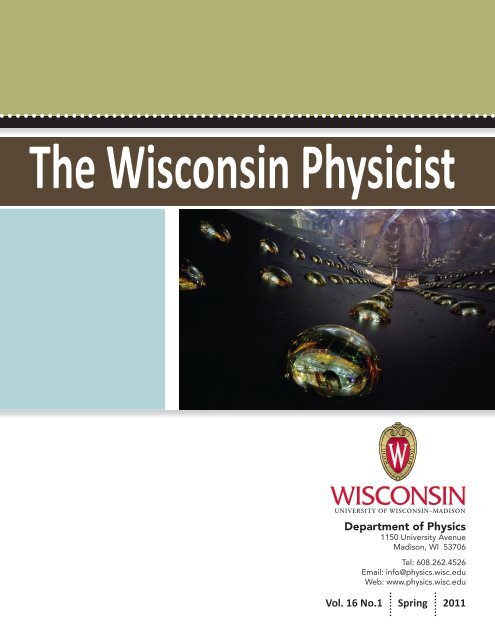

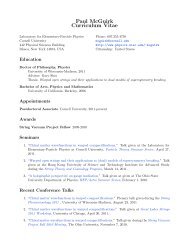
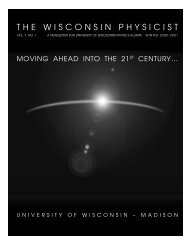
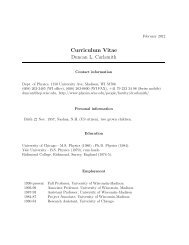
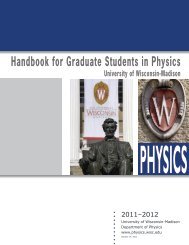

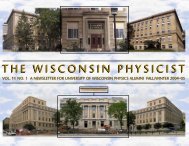

![The Symmetric Linear Potential [ ]](https://img.yumpu.com/25329322/1/190x245/the-symmetric-linear-potential-.jpg?quality=85)
